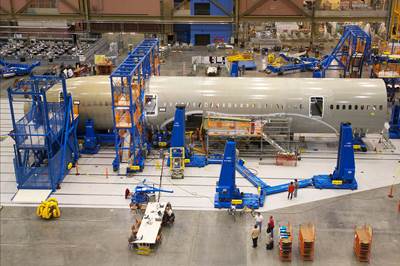
Photo Credit: Boeing
For almost a year now, Boeing (Chicago, Ill., U.S.) has been grappling with a composites-related problem on the 787 that has caused slowdown of aircraft production, significant inspection and rework of assembled aircraft, delayed deliveries of those aircraft, triggered similar inspections by Boeing airframer suppliers and highlighted one of the shortcomings of composites materials and process (M&P) use in large aerostructures. This problem, by extension, has also raised questions about composites use in next-generation aircraft.
The exact problem Boeing has discovered has not been fully and publicly disclosed, but we can draw a few conclusions from what we do know. First, the problem rests entirely in the fuselage joins, where one composite fuselage barrel section is connected to another. Second, there are two issues in some of these joins, which involve improperly sized shims used to fill gaps in the joins and the lack of flatness of the inner fuselage skin along the joining edge, causing the edge to fall out of conformity. Each issue by itself, according to reports, is not enough to affect the airworthiness of a 787, but taken together they pose a big enough concern that the U.S. Federal Aviation Administration (FAA) has asked Boeing to be more aggressive in its assessment and corrective action, as reported by the company in July.
To understand more fully the factors at work here, it’s important to understand how Boeing manufactures the 787 fuselage. The fuselage, comprising the skin, frames and stringers, is fabricated in sections, with each section manufactured by a different supplier. The forward fuselage section, including cockpit, is produced by Spirit AeroSystems (Wichita, Kan., U.S.). The section behind that is produced by Kawasaki Heavy Industries (Tokyo, Japan). The two center fuselage sections — including the largest on the aircraft — are produced by Leonardo (Rome, Italy). The two most aft fuselage sections are produced by Boeing itself. All fuselage sections are based on a single-piece barrel design, with prepregged carbon fiber deposited via automated fiber placement (AFP) around a collapsible mandrel. Finished fuselage sections are delivered by each supplier to Boeing in North Charleston, S.C., U.S., where the 787 is assembled.
What lessons can we draw from Boeing’s 787 experience to apply to next-gen aircraft?
Because the fuselage sections come from different suppliers, there are dimensional imperfections in the mating surfaces where one section is joined to another. Such imperfections are filled with shims cut to a specific size and shape for the join. Use of shims is common in aerocomposites manufacturing and their application to the 787 is not unusual. What is unusual is that a shim is improperly sized for the application, and this appears to have occurred on a certain number of 787s and has been attributed to a malfunctioning automated shim measurement and production system that has been fixed.
The cause of lack of flatness along the inner surface of the fuselage skin is more difficult to pin down, given the lack of detail supplied by Boeing. We do know this problem has been only reported in some sections, including those produced by Boeing and the one produced by Spirit AeroSystems. It’s easy to assume that the cause must be in fabrication — perhaps a chronic tooling flaw or a process control issue. Less discussed, but just as likely, is that the cause is in the design of the fuselage skin itself. Lack of flatness in a laminate implies fiber warpage or some other distortion, which could be attributed to the ply schedule developed for the skin.
In any case, it is puzzling that dimensional tolerance issues such as these are rearing their heads now, given the fact that the 787 has been in production for so long. A malfunctioning shim production system, although regrettable, is the type of manufacturing error that can and does happen, and is easily fixed. The lack of flatness in a laminate, however, if it’s caused by a design flaw, likely is not new to the 787; it may be that the shim problem led to the discovery of the skin flatness problem. Again, either of these issues by itself would not have caused a problem, but taken together, they have clearly raised some red flags.
Assuming Boeing gets these challenges ironed out, what lessons can we draw from this experience to apply to next-gen aircraft? Shimming has long been a necessity of composites manufacturing, but it’s high time that aerocomposites manufacturing evolve to obviate the need for these tools. And given all that we know about composites design and material behavior, developing a structural laminate that maintains dimensional tolerance should be trivial by now. Of course, the 787 was not designed recently. It was developed almost 20 years ago, so a new aircraft programs offers the opportunity to employ design and M&P technologies that did not exist 20 years ago, if we are willing to apply them.
Related Content
Looking at composites through the lens of U.S. history
When you’re a tourist with a background in writing for manufacturing it’s impossible not to notice all of the ways in which composites have resulted in significant milestones in the U.S. — historically and in the present.
Read MoreYour must-have composites industry guide for 2025
Welcome to CW’s annual SourceBook, your guide to suppliers of machinery, materials, software and other services for the composites industry.
Read MoreWho's ready for the Olympics?
With the 2024 Summer Olympics in Paris, this year’s JEC World is bound to be abuzz with talk of this year’s event — from the use of composites in sporting equipment to the roles they play in AAM.
Read MoreA return to JEC World
CW editor-in-chief Scott Francis reflects on the ways in which the composites industry has changed and also stayed the same based on observations from this year’s JEC World.
Read MoreRead Next
Boeing adjusts 2021 787 production downward
Persistent headwinds in international air travel have compelled Boeing to reduced 787 production from six to five per month by mid-2021.
Read MorePlant tour: Daher Shap’in TechCenter and composites production plant, Saint-Aignan-de-Grandlieu, France
Co-located R&D and production advance OOA thermosets, thermoplastics, welding, recycling and digital technologies for faster processing and certification of lighter, more sustainable composites.
Read More“Structured air” TPS safeguards composite structures
Powered by an 85% air/15% pure polyimide aerogel, Blueshift’s novel material system protects structures during transient thermal events from -200°C to beyond 2400°C for rockets, battery boxes and more.
Read More























